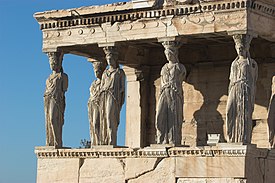"The Karyatids. They stood at the entrance to the Siphnian Treasury at Delphi."
A caryatid (/kæriˈætɪd/; Greek: Καρυάτις, plural: Καρυάτιδες) is a sculpted female figure serving as an architectural support taking the place of a column or a pillar supporting an entablature on her head. The Greek term karyatides literally means "maidens of Karyai", an ancient town of Peloponnese. Karyai had a famous temple dedicated to the goddess Artemis in her aspect of Artemis Karyatis: "As Karyatis she rejoiced in the dances of the nut-tree village of Karyai, those Karyatides, who in their ecstatic round-dance carried on their heads baskets of live reeds, as if they were dancing plants" (Kerenyi 1980 p 149).
...nitric acid used to test for gold...
Nitric acid (HNO3), also known as aqua fortis and spirit of niter, is a highly corrosive strong mineral acid. The pure compound is colorless, but older samples tend to acquire a yellow cast due to the accumulation of oxides of nitrogen. Most commercially available nitric acid has a concentration of 68%. When the solution contains more than 86% HNO3, it is referred to as fuming nitric acid. Depending on the amount of nitrogen dioxide present, fuming nitric acid is further characterized as white fuming nitric acid or red fuming nitric acid, at concentrations above 95%. Nitric acid is also commonly used as a strong oxidizing agent."Looks like JSTOR has them all."
Reactions with metals
Nitric acid reacts with most metals but the details depend on the concentration of the acid and the nature of the metal. Dilute nitric acid behaves as a typical acid in its reaction with most metals. Magnesium, manganese and zinc liberate H2. Others give the nitrogen oxides.[6]
Nitric acid can oxidize non-active metals such as copper and silver. With these non-active or less electropositive metals the products depend on temperature and the acid concentration. For example, copper reacts with dilute nitric acid at ambient temperatures with a 3:8 stoichiometry.
The nitric oxide produced may react with atmospheric oxygen to give nitrogen dioxide. With more concentrated nitric acid, nitrogen dioxide is produced directly in a reaction with 1:4 stoichiometry.
- 3 Cu + 8 HNO3 → 3 Cu2+ + 2 NO + 4 H2O + 6 NO3-
Upon reaction with nitric acid, most metals give the corresponding nitrates. Some metalloids and metals give the oxides, for instance, Sn, As, Sb, Ti are oxidized into SnO2, As2O5, Sb2O5 and TiO2 respectively.[6]
- Cu + 4 H+ + 2 NO3− → Cu2+ + 2 NO2 + 2 H2O
Some precious metals, such as pure gold and platinum group metals do not react with nitric acid, though pure gold does react with aqua regia, a mixture of concentrated nitric acid and hydrochloric acid. However, some less noble metals (Ag, Cu, ...) present in some gold alloys relatively poor in gold such as colored gold can be easily oxidized and dissolved by nitric acid, leading to colour changes of the gold-alloy surface. Nitric acid is used as a cheap means in jewelry shops to quickly spot low-gold alloys (< 14 carats) and to rapidly assess the gold purity.
JSTOR (short for Journal Storage) is an online system for archiving academic journals, founded in 1995. It provides its member institutions full-text searches of digitized back issues of several hundred well-known journals, dating back to 1665 in the case of the Philosophical Transactions of the Royal Society. Membership in JSTOR is held by 7,000 academic institutions in 159 countries.
JSTOR was originally funded by the Andrew W. Mellon Foundation, but is now an independent, self-sustaining not-for-profit organization with offices in New York City and Ann Arbor, Michigan. In January 2009, JSTOR merged with ITHAKA, becoming part of that organization. ITHAKA is a non-profit organization founded in 2003 "dedicated to helping the academic community take full advantage of rapidly advancing information and networking technologies."

No comments:
Post a Comment